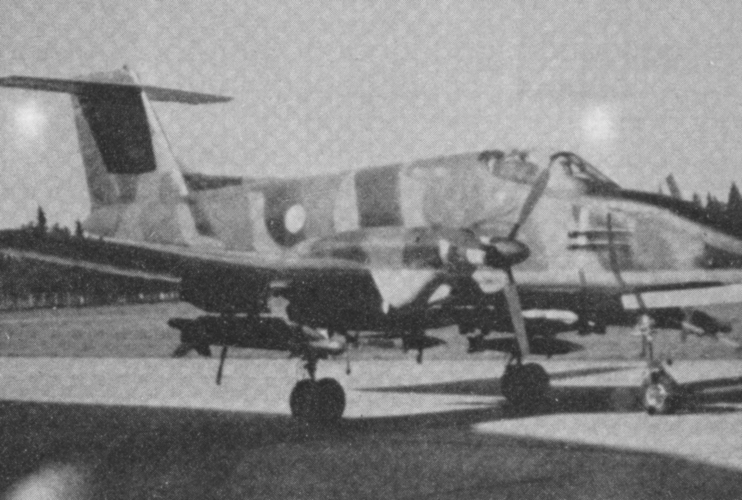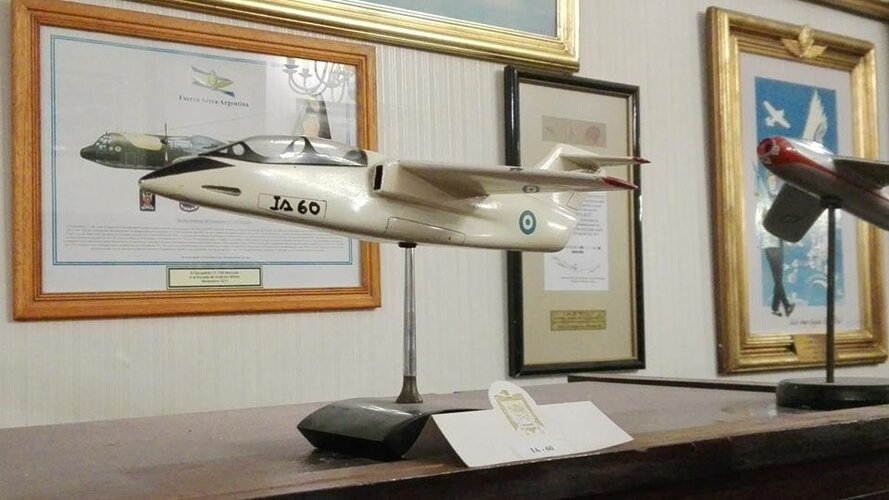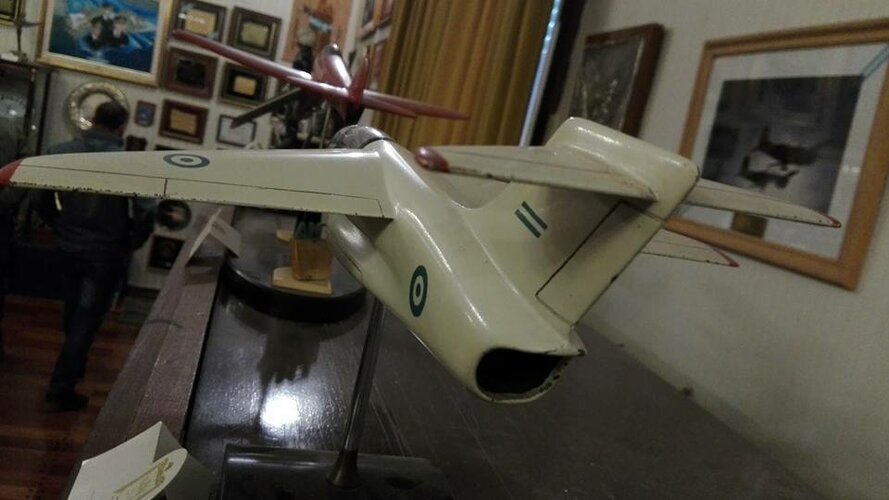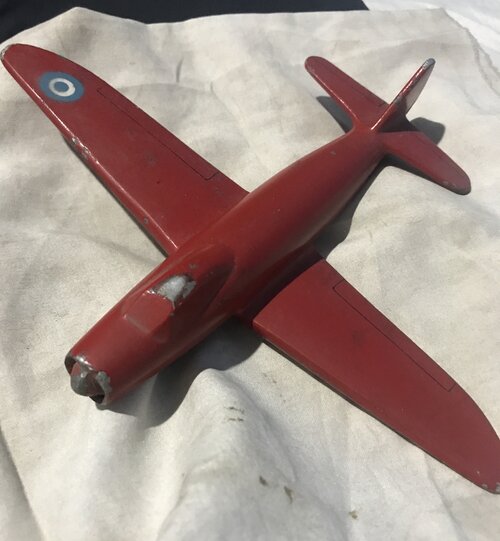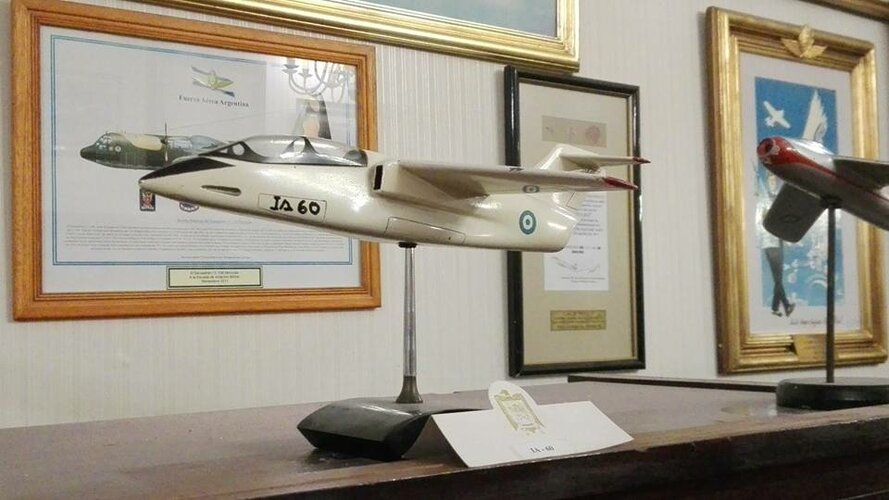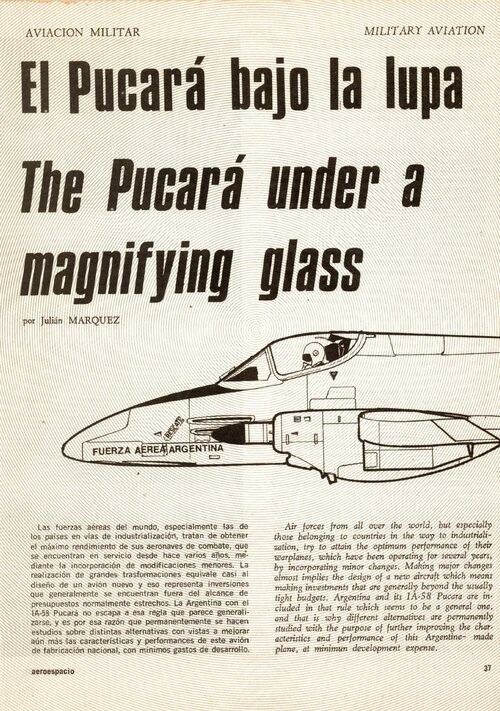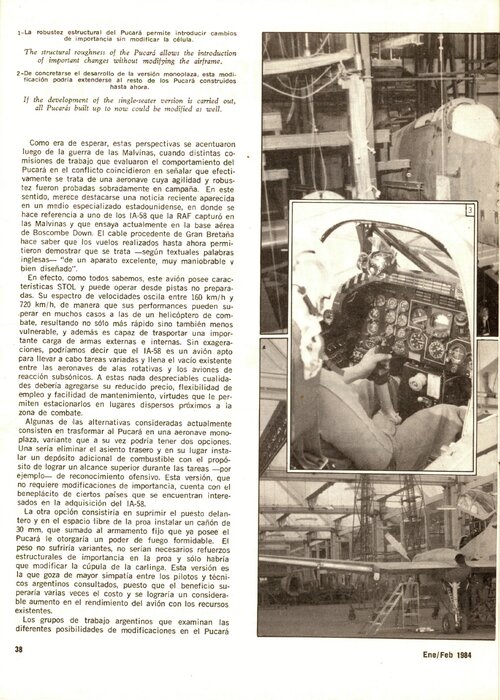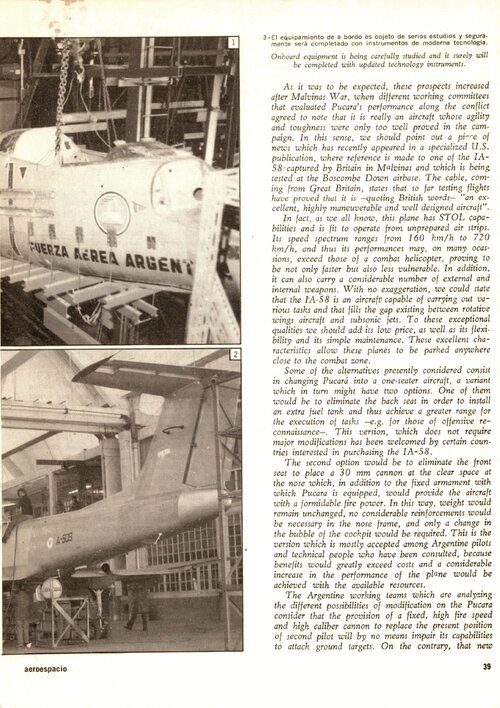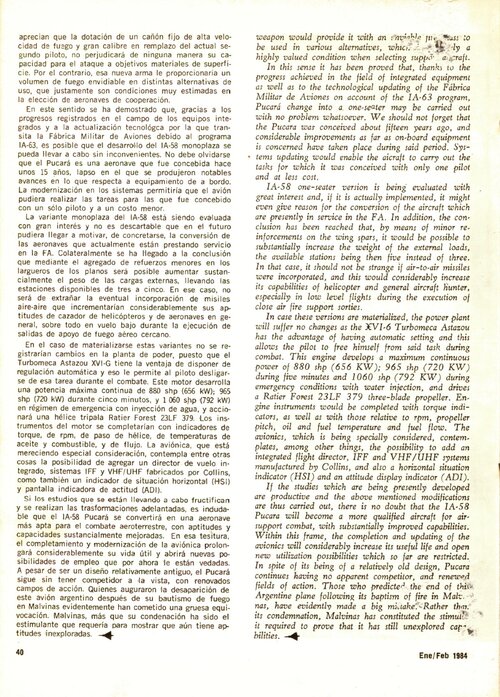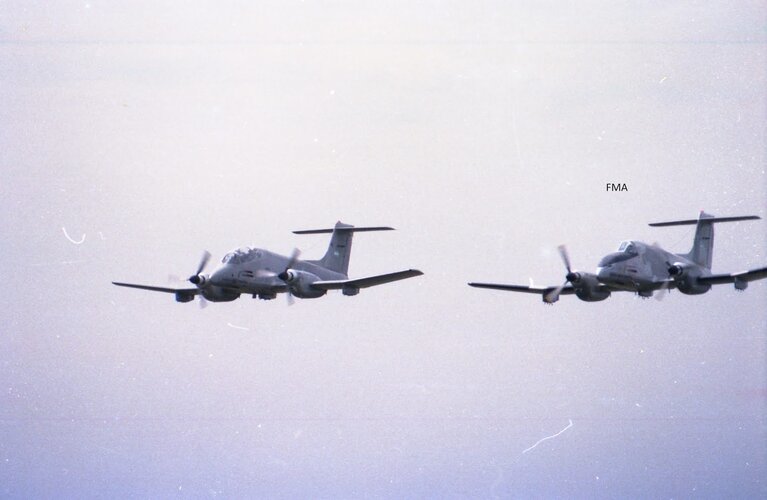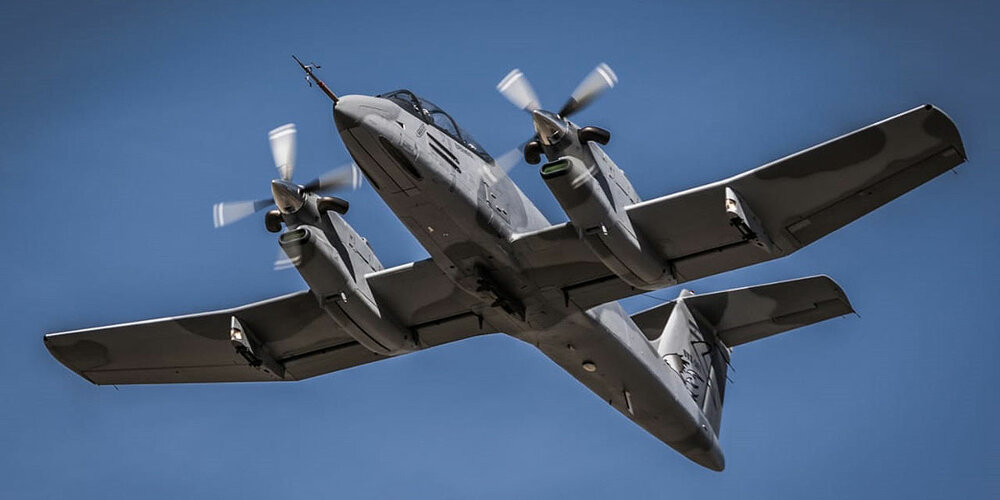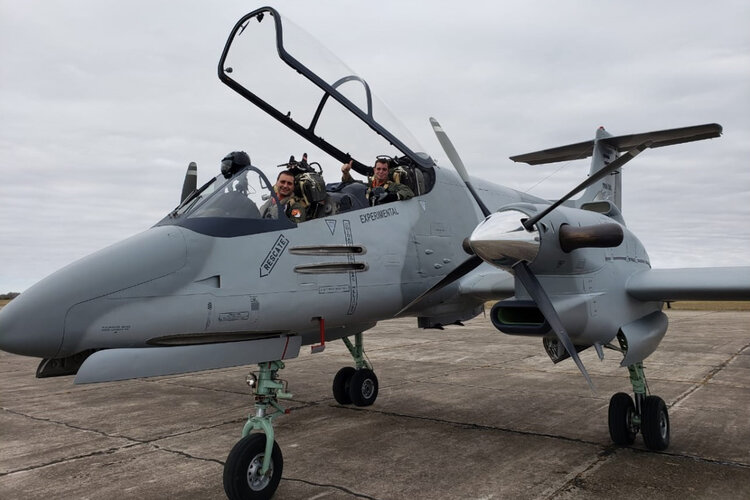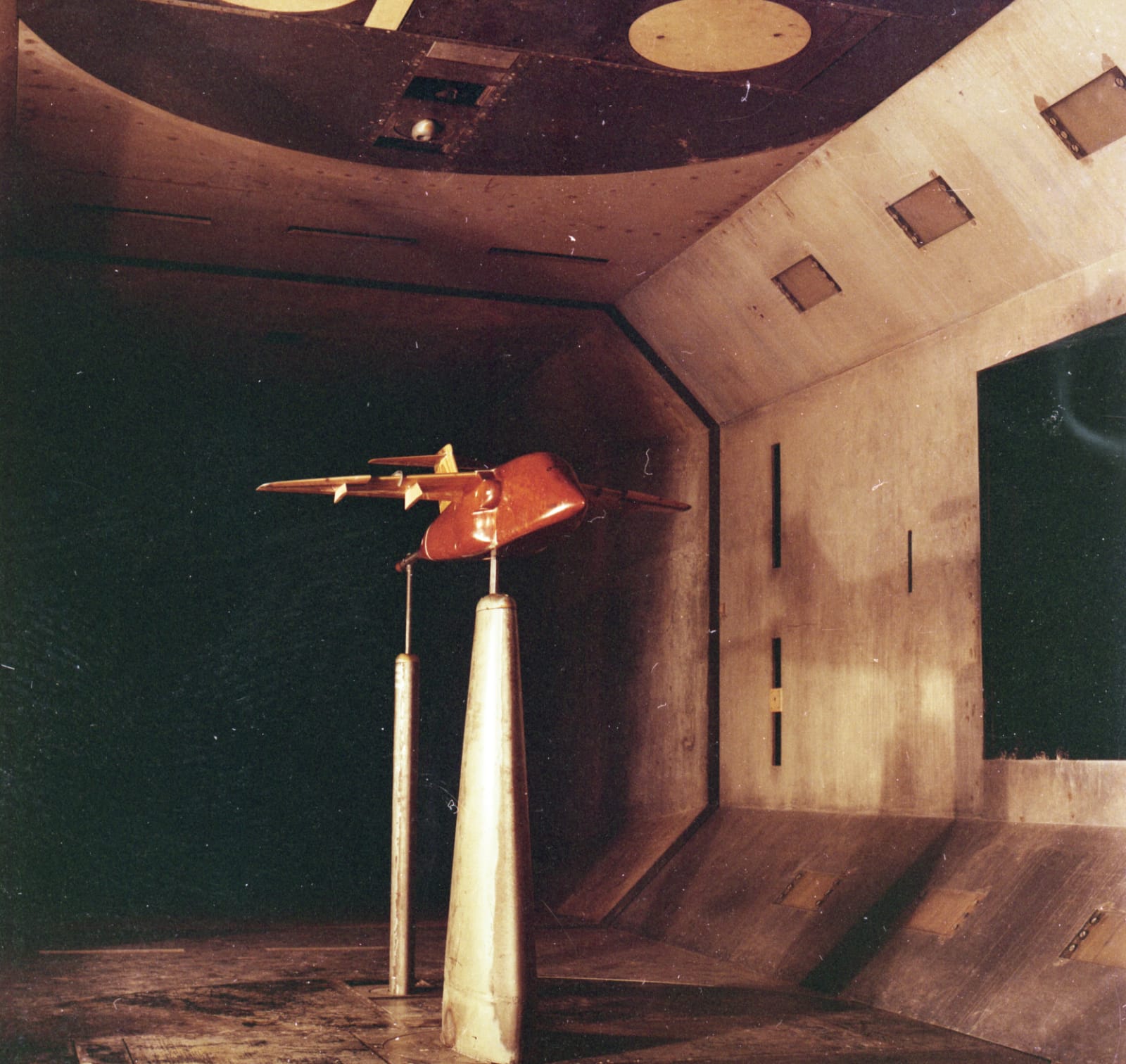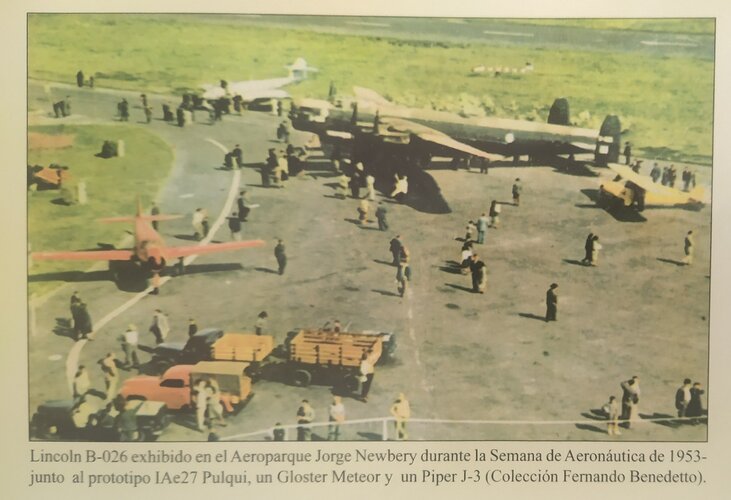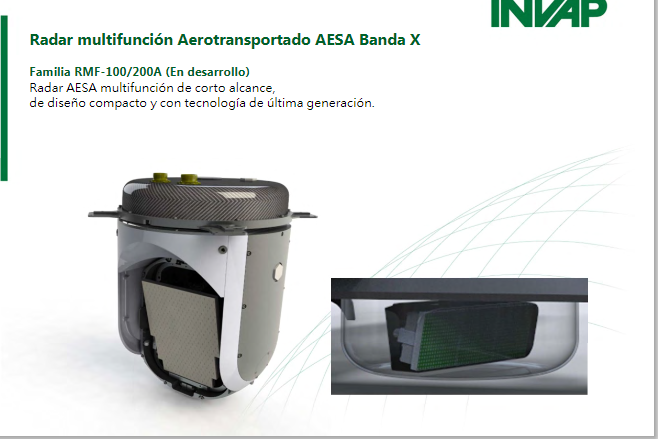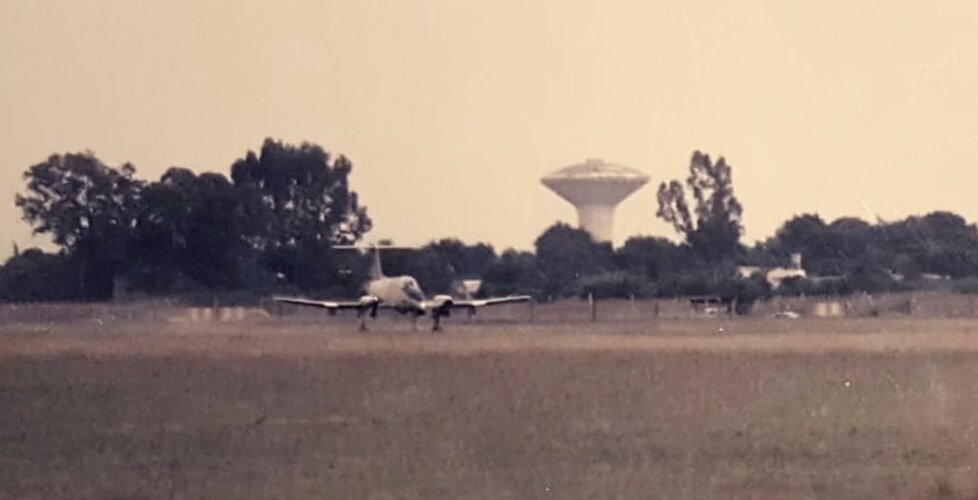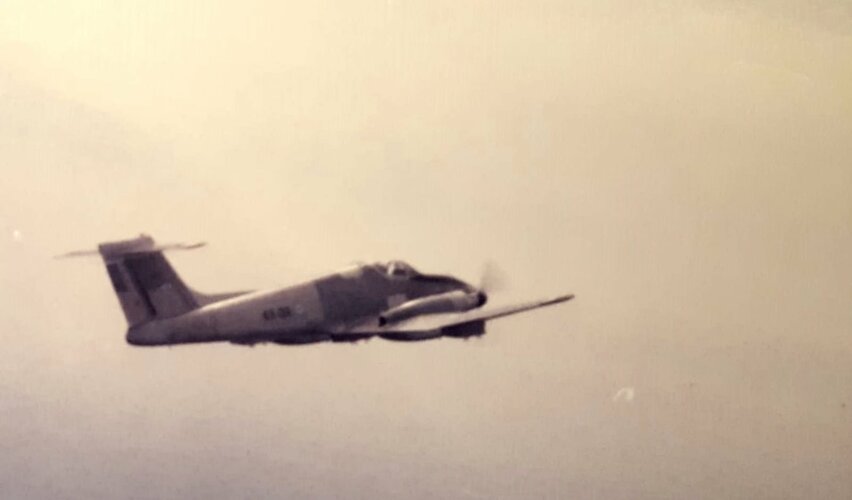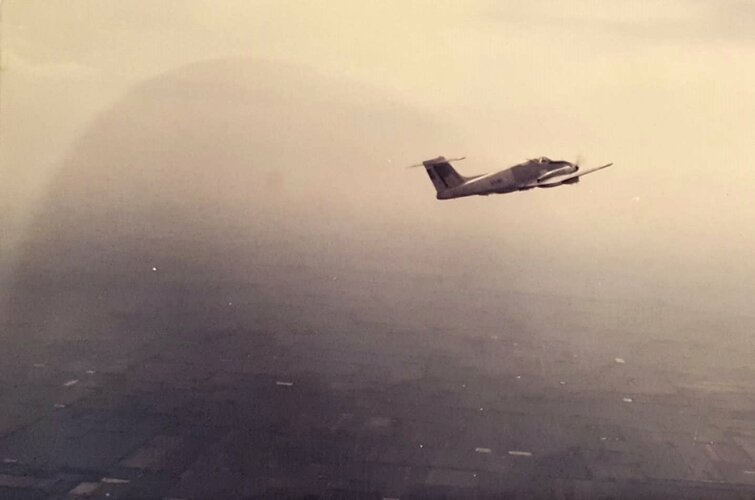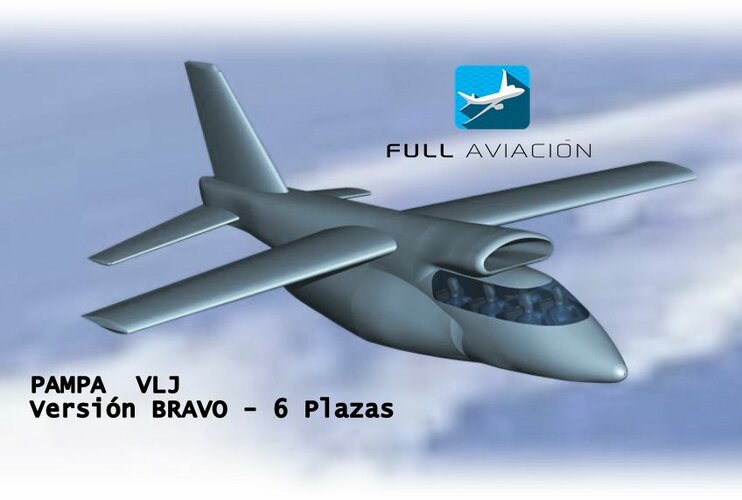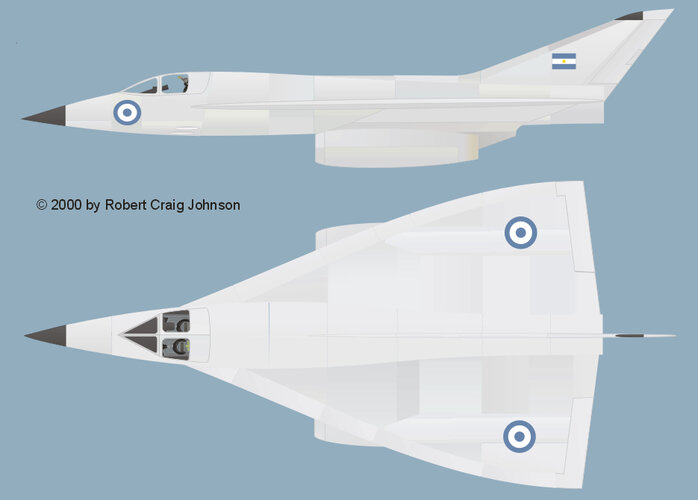You are using an out of date browser. It may not display this or other websites correctly.
You should upgrade or use an alternative browser.
You should upgrade or use an alternative browser.
Argentinian Unbuilt Projects
- Thread starter raravia
- Start date
Erdosain
ACCESS: Secret
- Joined
- 10 March 2020
- Messages
- 479
- Reaction score
- 1,976
Dos Décadas de Producción de la Fabrica Militar de Aviones
Two Decades of Production of the Military Aircraft Factory
Revista Nacional de Aeronáutica, Números correspondientes a los meses de Junio y Julio 1962.
National Aeronautical Magazine - June and July of 1962.

 www.facebook.com
www.facebook.com
Two Decades of Production of the Military Aircraft Factory
Revista Nacional de Aeronáutica, Números correspondientes a los meses de Junio y Julio 1962.
National Aeronautical Magazine - June and July of 1962.

Desarrollo Aeroespacial Argentino - Pasado, Presente y Futuro | Dos Décadas de Producción de la Fabrica Militar de Aviones | Facebook
Dos Décadas de Producción de la Fabrica Militar de Aviones Revista Nacional de Aeronáutica, Números correspondientes a los meses de Junio y Julio 1962.
 www.facebook.com
www.facebook.com
An old article detailing most FMA projects and aircraft made.So, beyond the FMA-related title and Facebook's "This content isn't available right now..." message, what was being communicated there?
- Joined
- 25 July 2007
- Messages
- 4,299
- Reaction score
- 4,196
An old article detailing most FMA projects and aircraft made.So, beyond the FMA-related title and Facebook's "This content isn't available right now..." message, what was being communicated there?
Thanks. Would it be reproducible here?
i guess? after all it looks a bit old. i dont see any issues with sharing it!An old article detailing most FMA projects and aircraft made.So, beyond the FMA-related title and Facebook's "This content isn't available right now..." message, what was being communicated there?
Thanks. Would it be reproducible here?
Also!
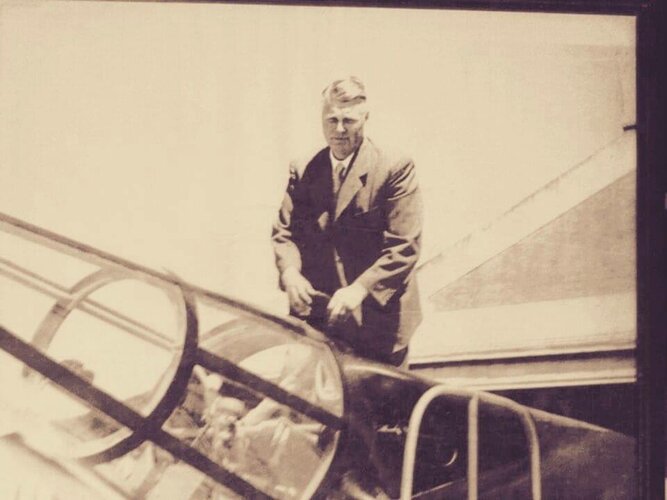
Horten in the I.Ae.37!!
Attachments
Erdosain
ACCESS: Secret
- Joined
- 10 March 2020
- Messages
- 479
- Reaction score
- 1,976
So, beyond the FMA-related title and Facebook's "This content isn't available right now..." message, what was being communicated there?
I thought the group was public. But if you apply to be a member of the group, you can access the very interesting PDF files.
I had already uploaded the images on the previous page
Last edited:
Attachments
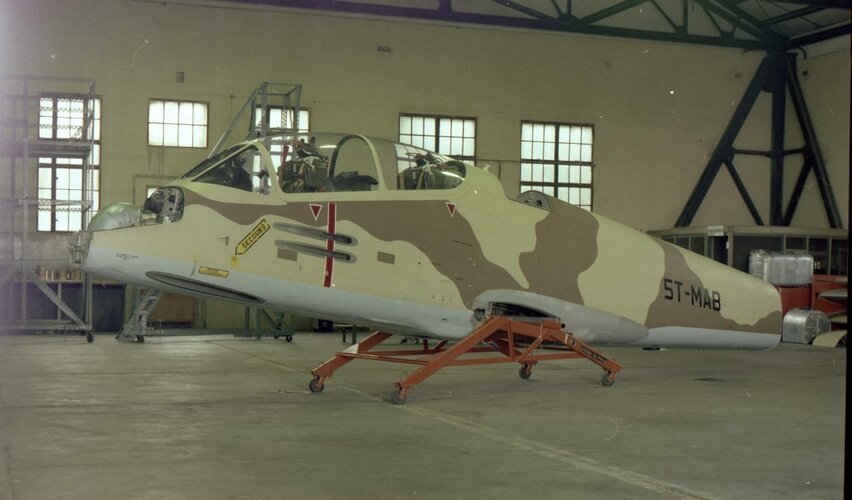
A recently disassembled Ia.58A in an interesting livery...this was one of the 2 examples that were sold to Mauritania, sadly for FMA a coup in Mauritania Halted and cancelled the sale for the aircraft. The 2 examples were absorbed/Purchased along another deal for The Argentine Air force, interestingly they conserved their livery, making them the only 2 units to ever use a desert camo.
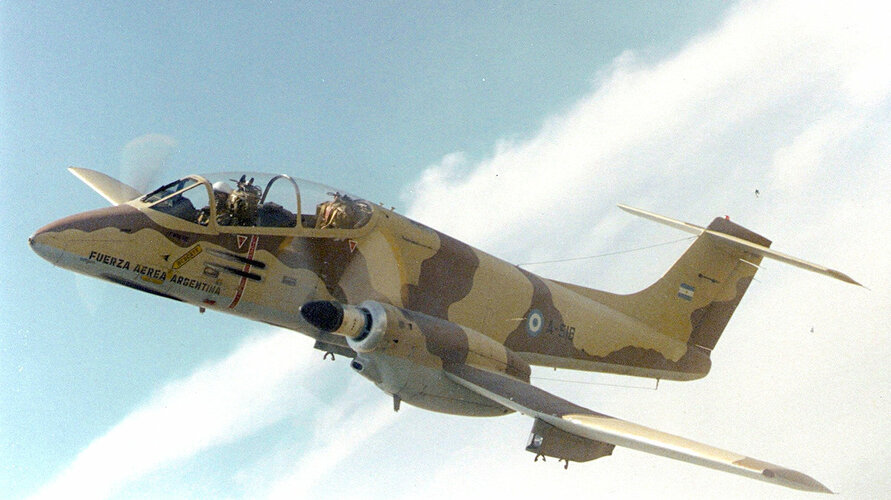
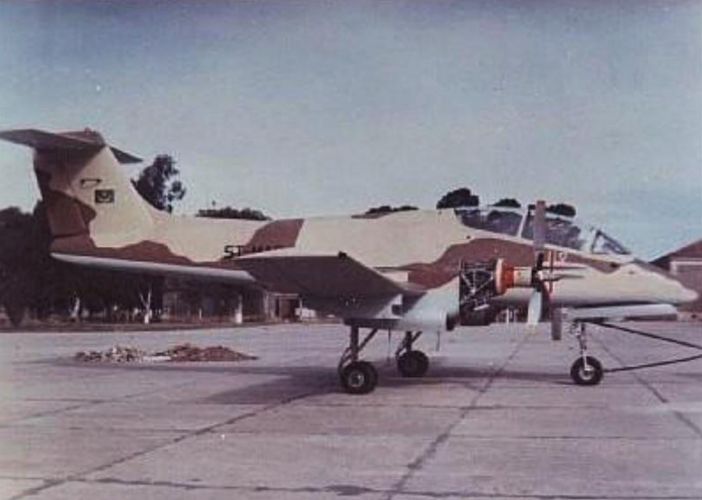
Complete example with the Mauritanian Camo
Something that i rarely seen being mentioned or covered are the upgrades of the Skyhawk family, some are well known, like the replacement of the cannons or the upgrade of navigational equipment, but in between this there were "lesser known" works to give them Countermeasures, more specifically RWR and Chaff/Flares. The only 2 models who received them were a certain number of Naval A-4Qs and also 2 Air Force A-4Cs with an indigenous RWR. The results of the Navy's testing is unknown, but the results of the Air Force were not satisfactory, thus the remaining fleet did not get the upgrade.

In the pic there is A-4Q "309" with a the RWR being clearly visible.
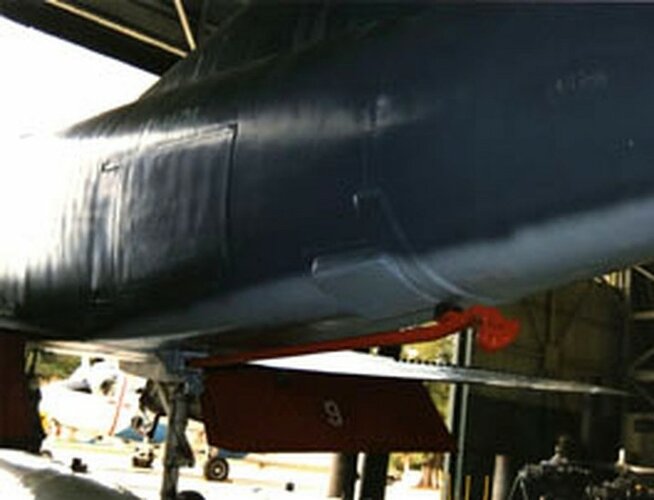
In the pic there is A-4Q "309" with a the RWR being clearly visible.
Erdosain
ACCESS: Secret
- Joined
- 10 March 2020
- Messages
- 479
- Reaction score
- 1,976
I withdraw what I have said in my previous post, although they occupy a broader period of the FMA, all the books that I cite take as a reference to Burzaco's book for that period.Llevo esperando trece años a que aparezca un editor con el suficiente... "right stuff" para hacer justicia al extraordinario trabajo de Burzaco, publicando sus libros en ingles.In my opinion, “Las Alas de Perón” has to be the most comprehensive book about the Golden age of Argentinian aviation industry.
Tan dificil y arriesgado seria hacer una edicion en Amazon-Kindle?
Es una cuestion de ideologia?.
Que problema puede haber en publicar un trabajo tan tecnico con background historico de todos conocido? yo no he encontrado ningun obstaculo a mis publicaciones en el mundo anglosajon.
Un saludo a todos y mis respeto por los demas autores.
I think that a corrected reissue is necessary, removing some myths and investigating projects that were recently released.
Unfortunately Alas de Peron is sold out and cannot be found in bookstores or on the web.
Luckily I have both editions of Alas de Perón
Erdosain
ACCESS: Secret
- Joined
- 10 March 2020
- Messages
- 479
- Reaction score
- 1,976
Erdosain
ACCESS: Secret
- Joined
- 10 March 2020
- Messages
- 479
- Reaction score
- 1,976
FMA A-58C Pucará Charly
Aeroespacio 446, July -August 1985
Aeroespacio 446, July -August 1985
Attachments
-
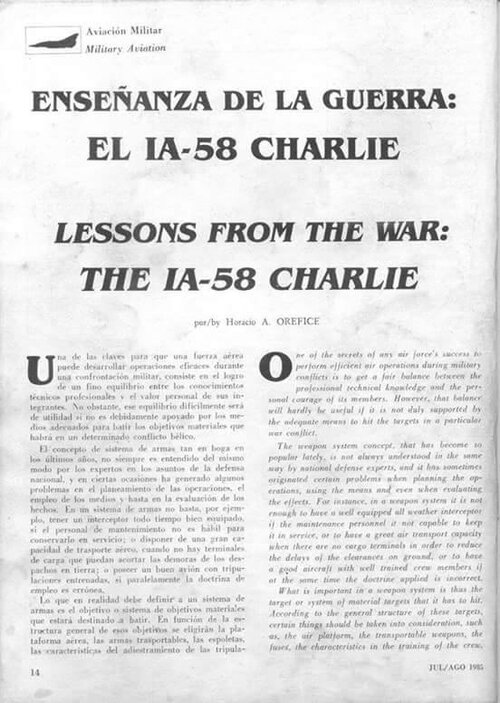 FMA IA-58C_01.jpg109.4 KB · Views: 100
FMA IA-58C_01.jpg109.4 KB · Views: 100 -
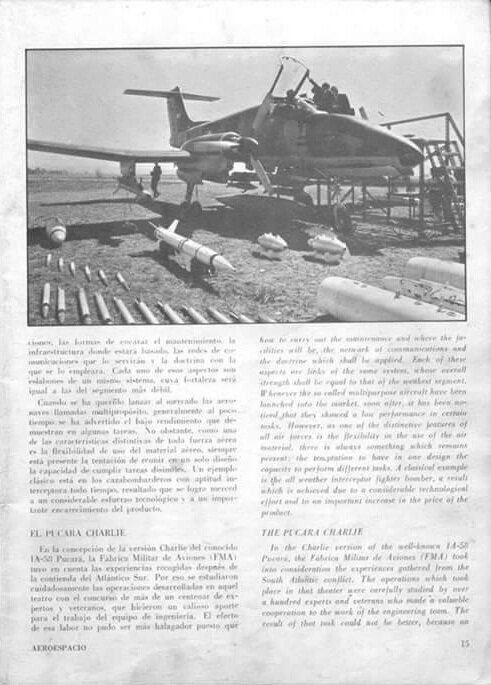 FMA IA-58C_02.jpg108.8 KB · Views: 122
FMA IA-58C_02.jpg108.8 KB · Views: 122 -
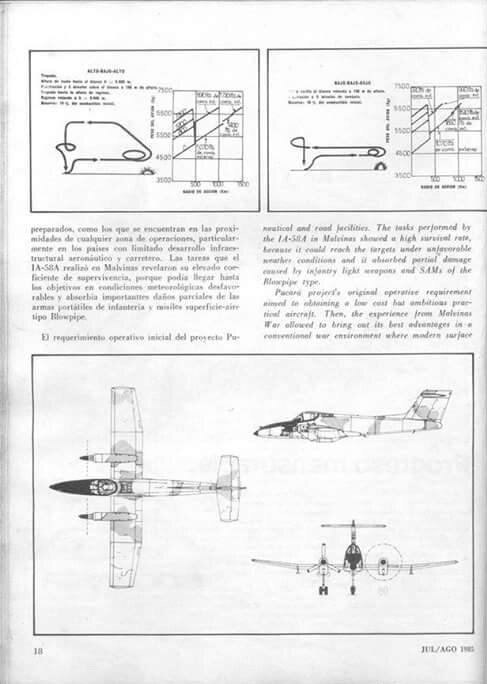 FMA IA-58C_04.jpg64.2 KB · Views: 140
FMA IA-58C_04.jpg64.2 KB · Views: 140 -
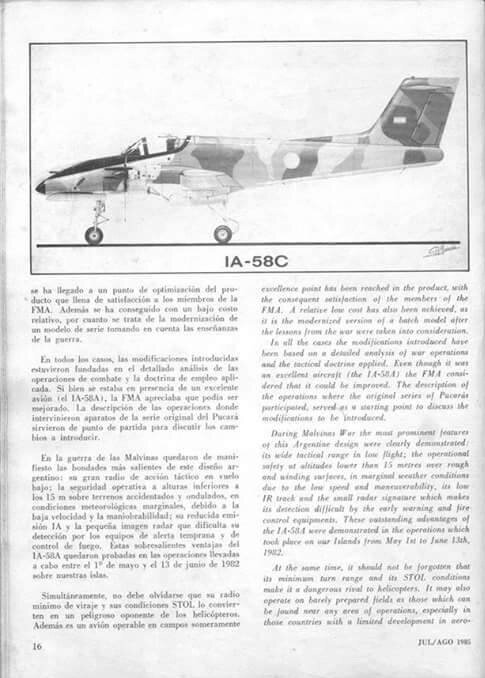 FMA IA-58C_03.jpg82.7 KB · Views: 141
FMA IA-58C_03.jpg82.7 KB · Views: 141 -
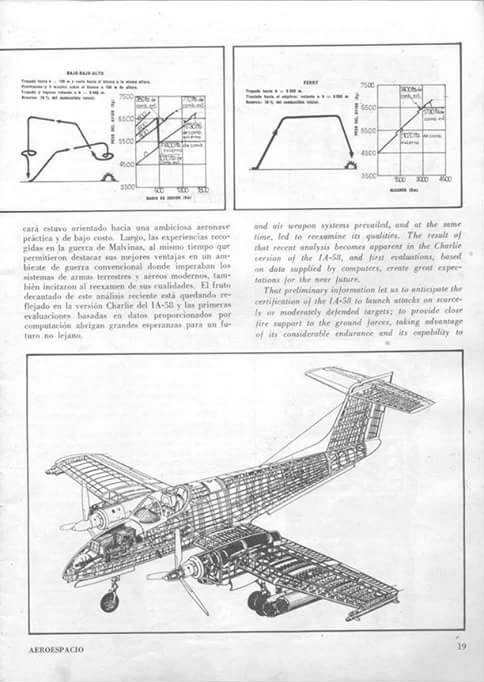 FMA IA-58C_05.jpg76.9 KB · Views: 128
FMA IA-58C_05.jpg76.9 KB · Views: 128 -
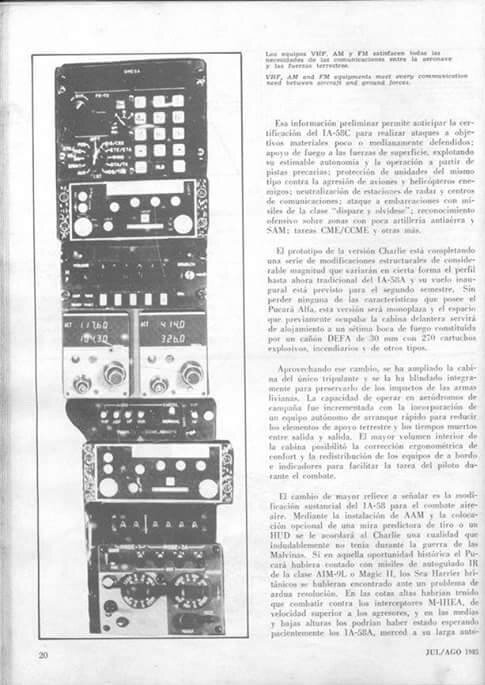 FMA IA-58C_06.jpg87.3 KB · Views: 105
FMA IA-58C_06.jpg87.3 KB · Views: 105 -
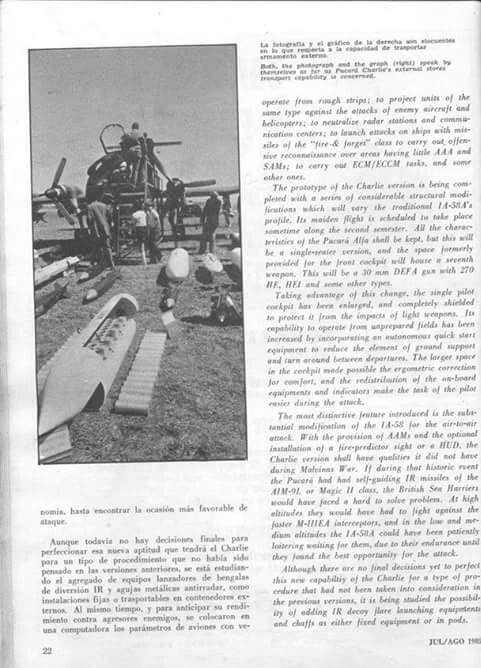 FMA IA-58C_07.jpg95.1 KB · Views: 105
FMA IA-58C_07.jpg95.1 KB · Views: 105 -
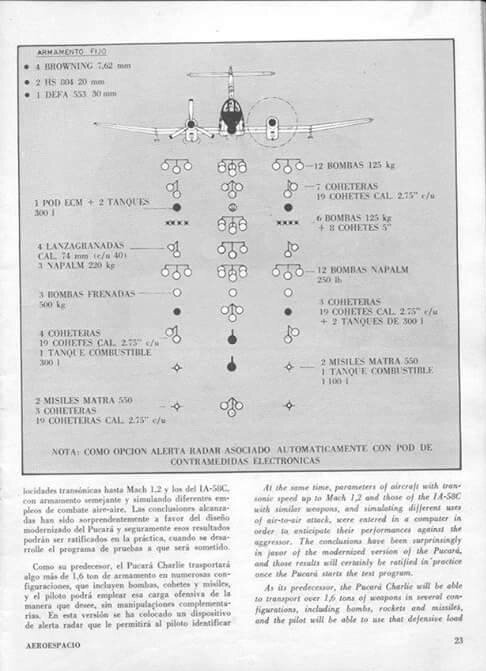 FMA IA-58C_08.jpg74.1 KB · Views: 110
FMA IA-58C_08.jpg74.1 KB · Views: 110 -
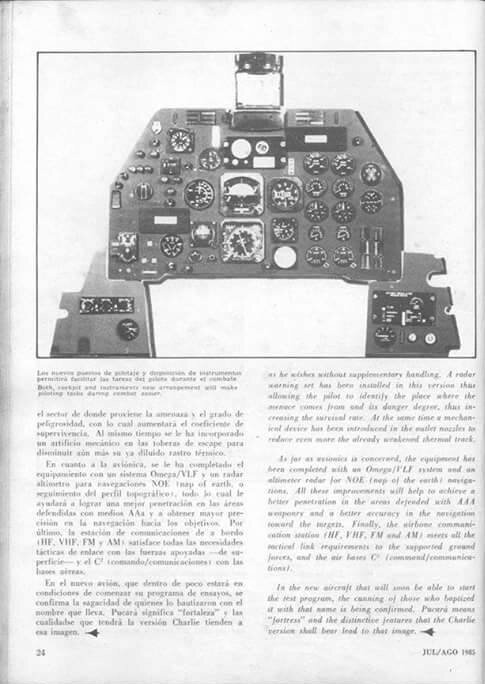 FMA IA-58C_09.jpg80.1 KB · Views: 112
FMA IA-58C_09.jpg80.1 KB · Views: 112
- Joined
- 18 June 2009
- Messages
- 1,412
- Reaction score
- 2,494
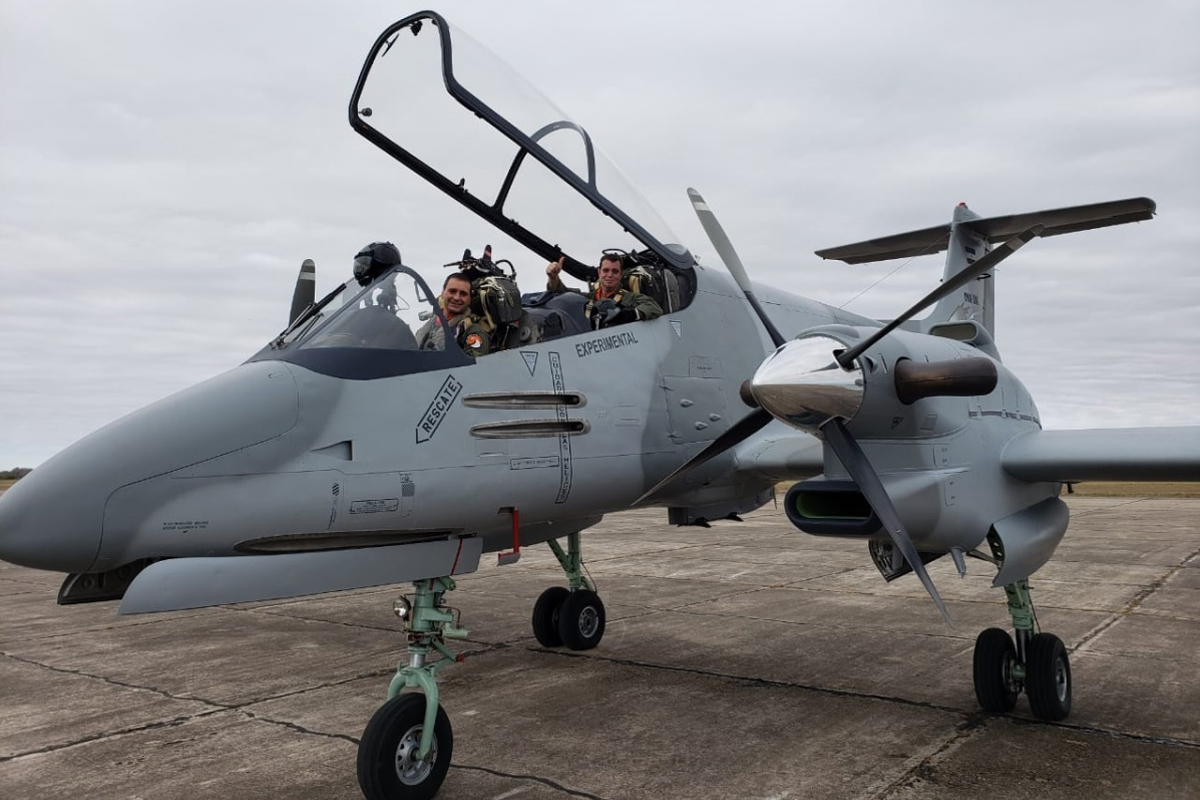
Argentina converts Pucará attack turboprop into Fénix version - Air Data News
During the ceremony of the aircraft's deactivation at Reconquista airbase, held on October 4, the FAA presented the first “Pucará Fénix”, a revamped version
Pucará Fénix
In August (2019) Fuerza Aérea Argentina (FAA) had announced that its IA-58 Pucará turboprop would be withdrawn after 44 years. However, the force has decided that the aircraft will remain operational but in a new role.
During the ceremony of the aircraft’s deactivation at Reconquista airbase, held on October 4, the FAA presented the first “Pucará Fénix”, a revamped version of the Argentine-produced military aircraft. Instead of the attack function, the role of the aircraft will become border surveillance and patrolling operations.
To develop the Pucará Fénix (Phoenix), the Turbomeca Astazou engines were replaced by the Pratt & Whitney Canada PT-6A-62, which uses four-bladed propellers instead of three, and the aircraft received FLIR search sensors, synthetic aperture radar, targeting laser and satellite communication system.
The conversion of the Pucará Fénix was made by FAdeA (Fábrica Argentina de Aviones), former FMA (Fábrica Militar de Aviones), manufacturer that designed the Pucará. The Argentine military command still plans to modify two more aircraft soon and intends to keep the new version of Pucará in operation for another 15 or 20 years.
Attachments
The Fenix is going to get a pod that combines a radar and a FLIR Sensor (kinda like a designator pod). The first prototype of it was a simple container housing an AESA radar made by INVAP, it was seen being tested not long ago.


For now the "Fenix" is keeping the internal weapons, although the idea of removing all armament was envisioned, the prototype still has both 20mm and the 4 machine guns. Much like the Super Tucano, it could still have some potential for COIN (after the upgrade of course).
And interestingly the Fenix its not the first time the Pucara changed engines
The IA.66
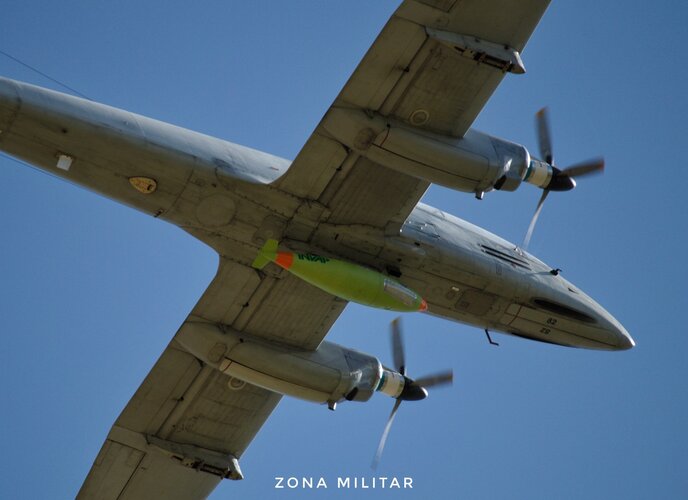
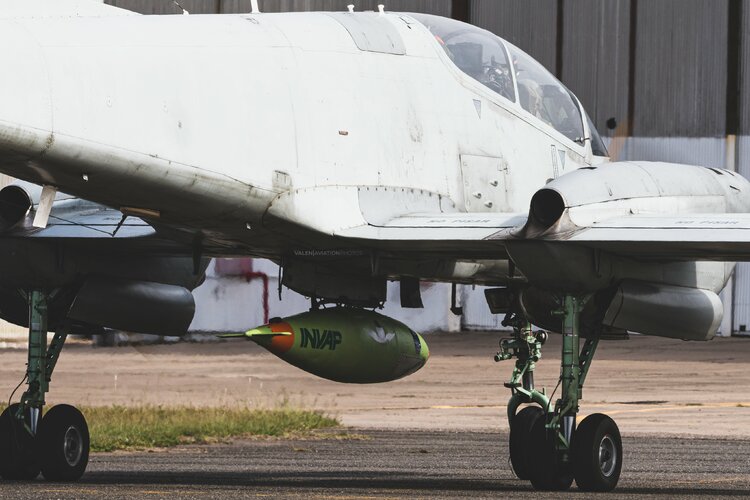
For now the "Fenix" is keeping the internal weapons, although the idea of removing all armament was envisioned, the prototype still has both 20mm and the 4 machine guns. Much like the Super Tucano, it could still have some potential for COIN (after the upgrade of course).
And interestingly the Fenix its not the first time the Pucara changed engines
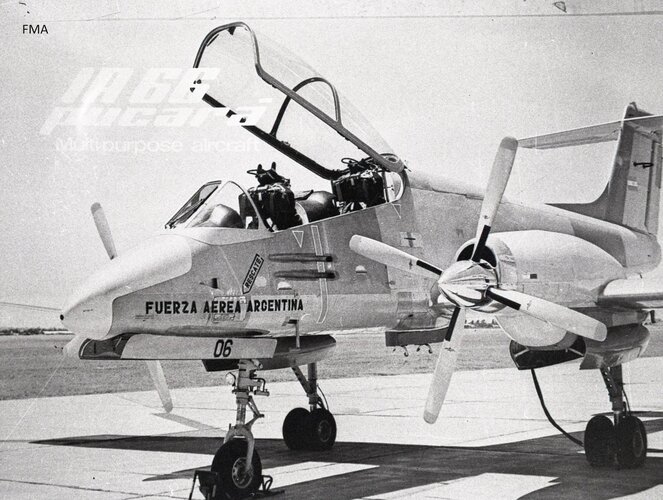
The IA.66
FMA A-58C Pucará Charly
Aeroespacio 446, July -August 1985
Something this plane has radar? Only the text is not read well in the pictures
As far as i can remember, it didn't have a radar (i could be wrong tho)FMA A-58C Pucará Charly
Aeroespacio 446, July -August 1985
Something this plane has radar? Only the text is not read well in the pictures
A bit of an interesting look at the original prototype of the IA.58, or A-X2/AX-02 as it was called, the design was different for the nose and its engines weren't the french we all know, they were American Garrett engines. its also interesting to note that the whole cockpit had a different design (guns were more exposed and protruded from the fuselage and the nose wasn't covered by a single piece cover like on the series aircraft. The engines were later changed for the series Astazou and the plane renamed AX-01
The reason of the change could be a better deal with France (who also supplied the Bastan for the Guarani II) or just that US made engines were subject to embargoes, were a bit lacking in performance compared to the french ones....who knows?

The pic is from the aircraft second presentation, behind it is the last Gloster Meteor to be overhauled in FMA.
Thankfully AX-02 survives, and we can find it in the Air museum, although i believe they dont have a series pucara to make a good comparison.

The reason of the change could be a better deal with France (who also supplied the Bastan for the Guarani II) or just that US made engines were subject to embargoes, were a bit lacking in performance compared to the french ones....who knows?
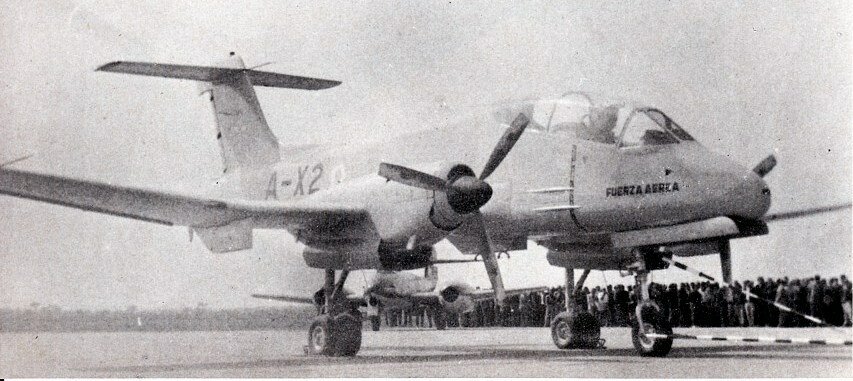
The pic is from the aircraft second presentation, behind it is the last Gloster Meteor to be overhauled in FMA.
Thankfully AX-02 survives, and we can find it in the Air museum, although i believe they dont have a series pucara to make a good comparison.
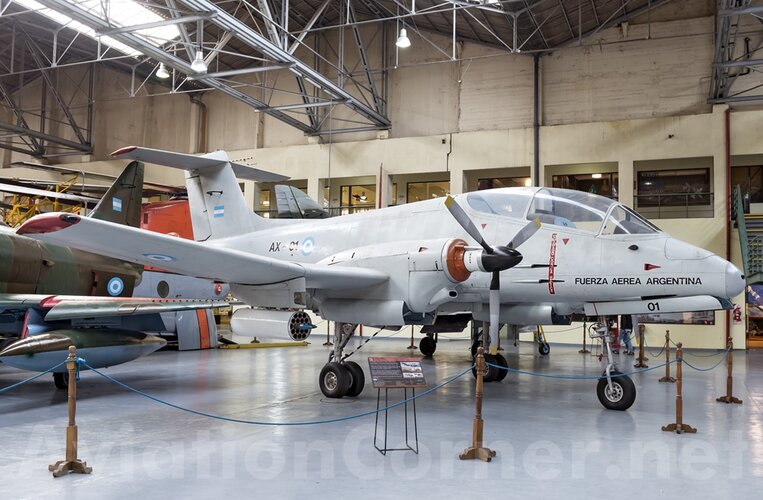
Hello, does anybody still has access to this pdf ? It seems the server is down.pometablava said:Do you have a bit more info about the book
you mentions
That's your link:

The direct link to the HUGE 25.8MB .pdf book :
http://www.mincyt.cba.gov.ar/site/fabricamilitar/descarga/fma2008.pdf
Considering the file size and low speed of the connection, I would suggest right clicking the link and selecting "Save Link As" instead of attempting to open it in the browser.
COLDOWN
ACCESS: Secret
- Joined
- 12 November 2019
- Messages
- 244
- Reaction score
- 318
Yes https://drive.google.com/file/d/1dW_tvLYwfbPqVVuvOp9itHOvUdn_BrGl/view?usp=sharingHello, does anybody still has access to this pdf ? It seems the server is down.pometablava said:Do you have a bit more info about the book
you mentions
That's your link:

The direct link to the HUGE 25.8MB .pdf book :
http://www.mincyt.cba.gov.ar/site/fabricamilitar/descarga/fma2008.pdf
Considering the file size and low speed of the connection, I would suggest right clicking the link and selecting "Save Link As" instead of attempting to open it in the browser.
Awesome !!! Thank you very much !!!Yes https://drive.google.com/file/d/1dW_tvLYwfbPqVVuvOp9itHOvUdn_BrGl/view?usp=sharingHello, does anybody still has access to this pdf ? It seems the server is down.pometablava said:Do you have a bit more info about the book
you mentions
That's your link:

The direct link to the HUGE 25.8MB .pdf book :
http://www.mincyt.cba.gov.ar/site/fabricamilitar/descarga/fma2008.pdf
Considering the file size and low speed of the connection, I would suggest right clicking the link and selecting "Save Link As" instead of attempting to open it in the browser.
I was going to post about the I.Ae.22DL prototypes, but i stumbled on this..

As far as i know, its supposed to be a "battery pack" to help the aircraft start easily in places where power wouldn't be really available. Pretty nifty i say...if all the sudden you find yourself deployed in the middle of a jungle or desert.
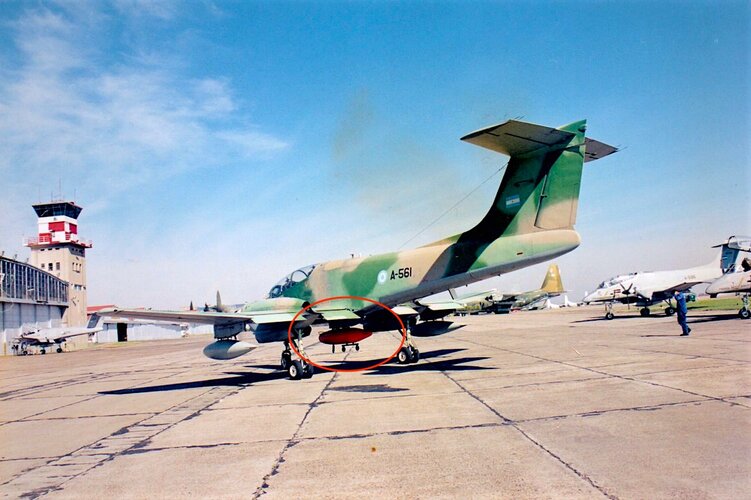
As far as i know, its supposed to be a "battery pack" to help the aircraft start easily in places where power wouldn't be really available. Pretty nifty i say...if all the sudden you find yourself deployed in the middle of a jungle or desert.
Before the beloved I.Ae.22 "DL" there was...the FMA-21?...yes, the predecesor that lacked the I.Ae.XX designation was along the lines of a "testbed/demonstrator" rather than a prototype that was aimed for manufacture.
If you're familiar with the early/mid stages of the Argentine Army Air Corps (it wasn't air force yet), their first "modern" trainer was the North American NA-16, a low wing fixed landing gear prop that was used for training, Observation and as a light attack aircraft (thats a pretty recurring thing with trainers here).

With the creation of the "Aerotechnical" institute in 1943, they started working on the replacement of NA-16s, due to the war limiting the amount of materials available for this work, it was decided to work with wood (much like DeHavilland). The aircraft wasn't built from the ground up, as the Institute was leased the NA-18, the demonstrator that was used to promote the NA-16 to the Air Corps (that was bought along the order...another recurring thing). The trainer was strip from its wings, landing gear and engine, and replaced with indigenous parts (engine was replaced by an I.Ae.16 "El Gaucho"). and the result was...this:

The New plane was designated FMA-21 and it first flew in 1943. it would be kept on service until 1948 (a year after the retirement of the NA-16s). The testing and working made on the FMA-21 would be later applied to the 22DL, but major changes would be seen as the later was more inclined to the design of the "Texan" trainer.
If you're familiar with the early/mid stages of the Argentine Army Air Corps (it wasn't air force yet), their first "modern" trainer was the North American NA-16, a low wing fixed landing gear prop that was used for training, Observation and as a light attack aircraft (thats a pretty recurring thing with trainers here).
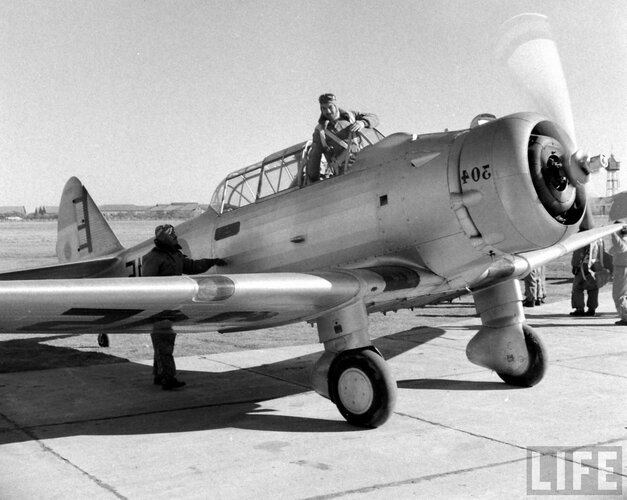
With the creation of the "Aerotechnical" institute in 1943, they started working on the replacement of NA-16s, due to the war limiting the amount of materials available for this work, it was decided to work with wood (much like DeHavilland). The aircraft wasn't built from the ground up, as the Institute was leased the NA-18, the demonstrator that was used to promote the NA-16 to the Air Corps (that was bought along the order...another recurring thing). The trainer was strip from its wings, landing gear and engine, and replaced with indigenous parts (engine was replaced by an I.Ae.16 "El Gaucho"). and the result was...this:
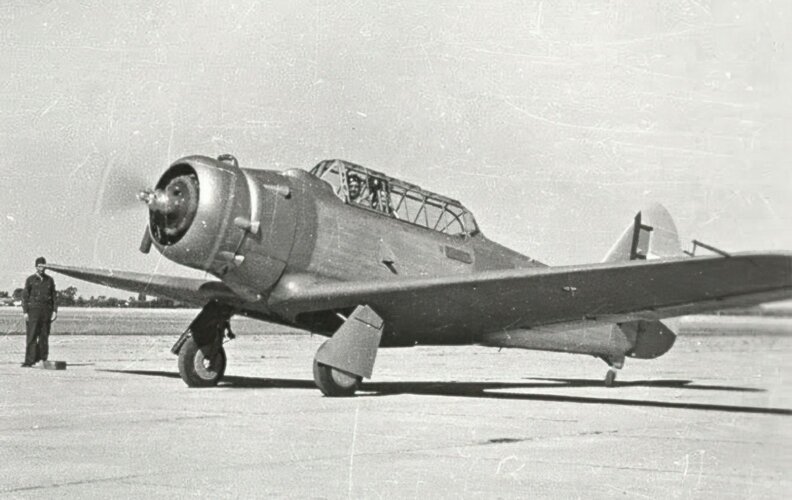
The New plane was designated FMA-21 and it first flew in 1943. it would be kept on service until 1948 (a year after the retirement of the NA-16s). The testing and working made on the FMA-21 would be later applied to the 22DL, but major changes would be seen as the later was more inclined to the design of the "Texan" trainer.
Erdosain
ACCESS: Secret
- Joined
- 10 March 2020
- Messages
- 479
- Reaction score
- 1,976
that's the towed targetIba a publicar sobre los prototipos I.Ae.22DL, pero me encontré con esto ...
View attachment 663881
Hasta donde yo sé, se supone que es un "paquete de baterías" para ayudar al avión a arrancar fácilmente en lugares donde la energía no estaría realmente disponible. Bastante ingenioso, digo ... si de repente te encuentras desplegado en medio de una jungla o desierto.
Target is open at the back, it has a pointier nose and lack the wheels, this was a “battery pack”that's the towed targetIba a publicar sobre los prototipos I.Ae.22DL, pero me encontré con esto ...
View attachment 663881
Hasta donde yo sé, se supone que es un "paquete de baterías" para ayudar al avión a arrancar fácilmente en lugares donde la energía no estaría realmente disponible. Bastante ingenioso, digo ... si de repente te encuentras desplegado en medio de una jungla o desierto.
Erdosain
ACCESS: Secret
- Joined
- 10 March 2020
- Messages
- 479
- Reaction score
- 1,976
El objetivo está abierto en la parte posterior, tiene una punta más puntiaguda y carece de ruedas, esto era un "paquete de baterías"ese es el objetivo remolcadoIba a publicar sobre los prototipos I.Ae.22DL, pero me encontré con esto ...
[ATTACH = full] 663881 [/ ATTACH]
Hasta donde yo sé, se supone que es un "paquete de baterías" para ayudar al avión a arrancar fácilmente en lugares donde la energía no estaría realmente disponible. Bastante ingenioso, digo ... si de repente te encuentras desplegado en medio de una jungla o desierto.
Ok, you were right. It looks very handmade, maybe they only made one. I understand they called it "POD PUA"
Another photo of the orange "Pod PUA" in flight.
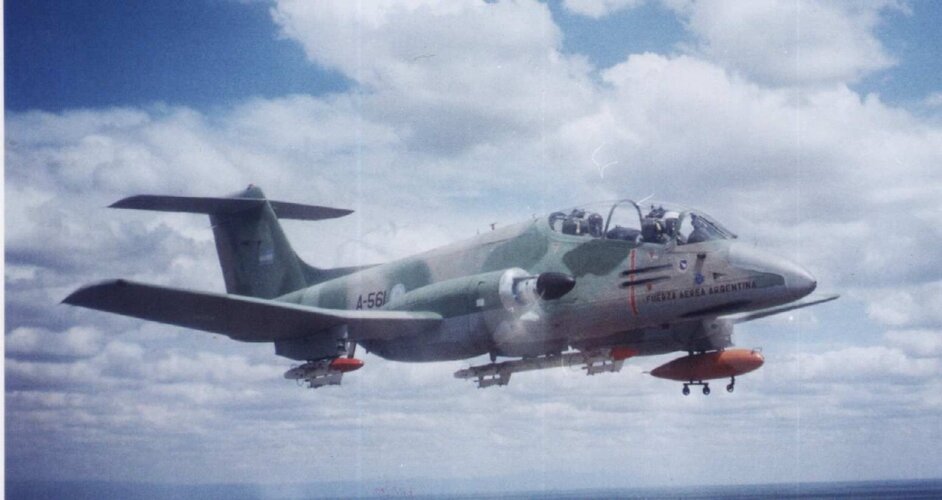
Wow, thanks for the photo!! (another, enlarged by AI)El objetivo está abierto en la parte posterior, tiene una punta más puntiaguda y carece de ruedas, esto era un "paquete de baterías"ese es el objetivo remolcadoIba a publicar sobre los prototipos I.Ae.22DL, pero me encontré con esto ...
[ATTACH = full] 663881 [/ ATTACH]
Hasta donde yo sé, se supone que es un "paquete de baterías" para ayudar al avión a arrancar fácilmente en lugares donde la energía no estaría realmente disponible. Bastante ingenioso, digo ... si de repente te encuentras desplegado en medio de una jungla o desierto.
Ok, you were right. It looks very handmade, maybe they only made one. I understand they called it "POD PUA"
Another photo of the orange "Pod PUA" in flight.
View attachment 663959
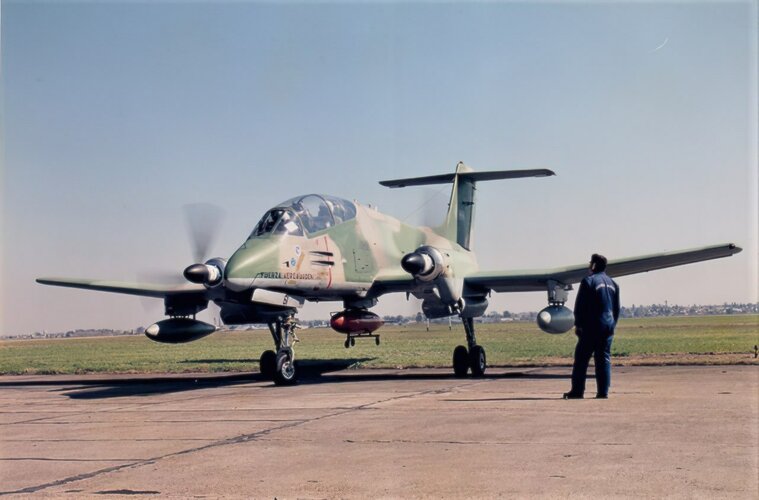
And here is a comparison with the target towing pod
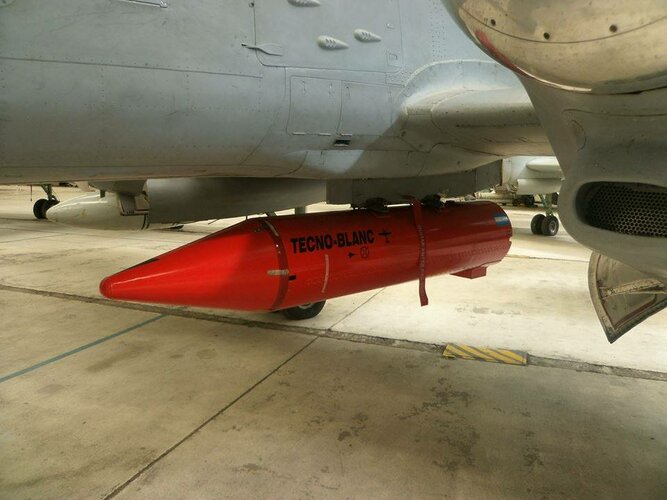
klem
I really should change my personal text
- Joined
- 7 March 2015
- Messages
- 726
- Reaction score
- 1,633
The D.720 Dewoitine reminds me the Lockheed F-80 with its air intakes.Fighter Dewoitine D.720 (1947), the last project of the French designer for the Argentine government and the FMA after the I.Ae.27 Pulqui I. I think it was rejected in favor of Pulqui II by Kurt Tank
All news regarding the Ia.58C are good news (obviously, since there is not much about it  )
)
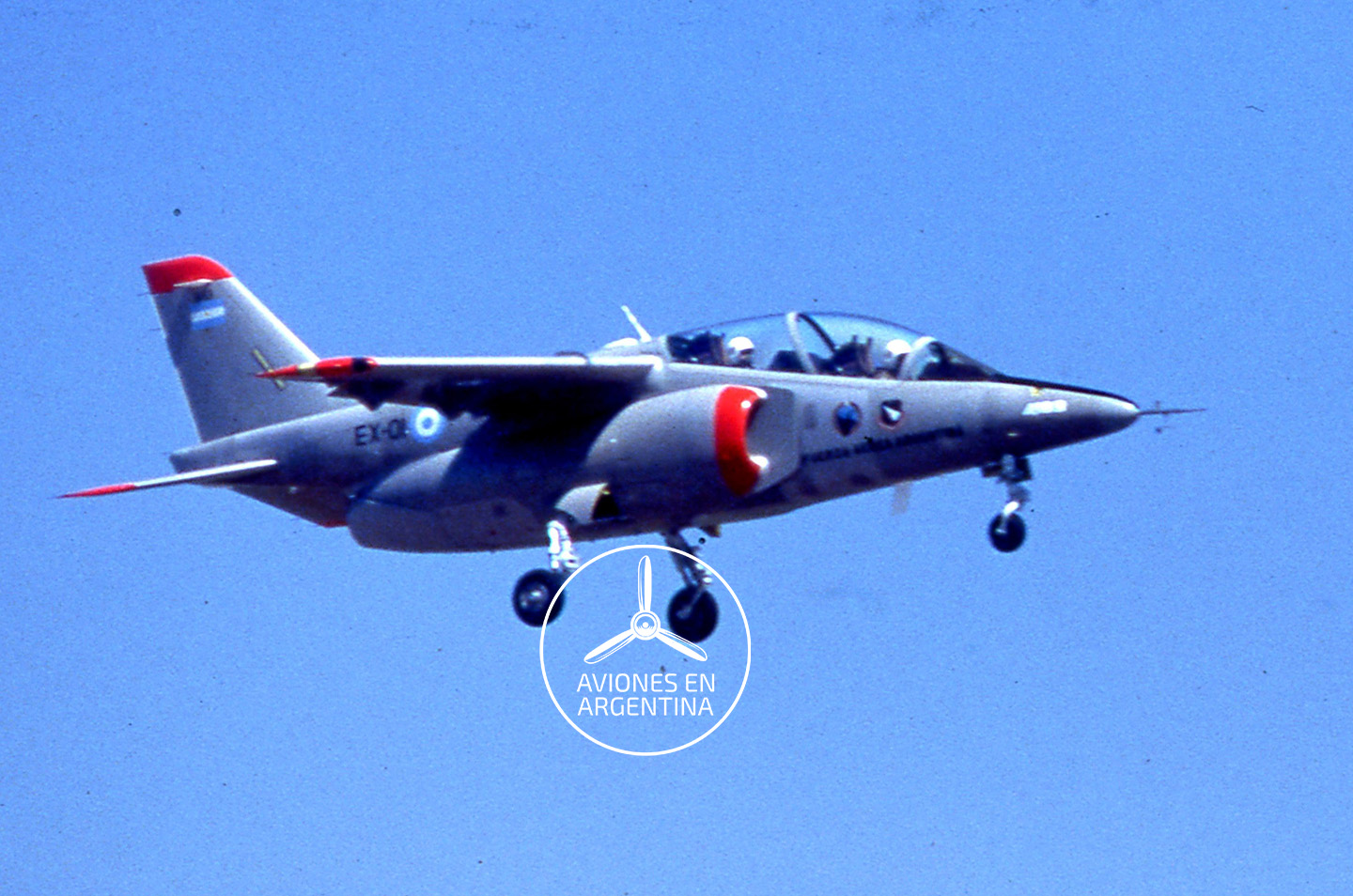
 avionesenargentina.com
avionesenargentina.com
On this 2x1 article (First flight of the Pampa and Presentation of the IA.58C) there is quite a bit about the rare prototype and its beginnings. (given the fact that the page protects all text and images from being copied, ill make the translation)
First Flight of the IA-63 Pampa trainer
On October 10th 1984 at 12hs the IA-63 Pampa serial EX-01 (first prototype) took its maiden flight from the airstrip at the Military Aviation school, commanded by ViceComodoro Genaro Mario Sciola in the back seat, while on the forward sea there was Mayor Horacio Armando Orefice. The IA-63 was escorted by a Morane Saulnier 760 "Paris" during the whole flight. The ceremony was preceded by the Chief of The Air Force, Brig My. Crespo and the Governor of the procure, Dr. Angeloz in between other military and Civilian Authorities.
Presentation of the IA-58C
At the same time that the Pampa took its maiden flight, the formal presentation of the IA-58C (Charly or Charlie, i like the first one best) was taking place.
The IA-58C was the third modification of the Original IA-58A (Alfa or Alpha) to improve in things like firepower and in certain aspects observed by pilots who flew the original type during the recent war with the Uk. The first modification (and perhaps the most noticeable one) was the elimination of the forward position, and in its place a 30mm DEFA cannon its added along with its ammo container, the two 20mm HISPANO SUIZA cannons are retained, it could also carry 2 MARTIN PESCADOR or MATRA MAGIC missiles, two of the four machine guns were removed and the remaining 2 were left mostly for training. Its Technical characteristics were similar to the original Alpha/Alfa model, but its aerodynamic penetration was higher, making it more maneuverable and agile.
The basis of the modification was to adapt the Pucara for Air-Air combat, this was done with the inclusion of AAMs and a proper HUD (things that the Series IA-58A aircraft lacked), Its payload capacity also rose to 1600Kg including bombs, rockets and missiles. The plane also saw the addition of RWR, and Heat dissipators to reduce its IR image to Heat seeking missiles.
In terms of avionics, the aircraft received an Omega/VLF system, an altimeter radar for navigation, NOE (Map of earth) for following the topographic profile of the zone, this was of great help in defended zones. In terms of communications HF-VHF-FM-AM satisfied all the tactical needs of communications with friendly surface forces and with Command in bases. Another 2 things that were added were a Garret Air conditioner and a Photo Sonics camera.
Today this aircraft its exposed in the "Area Material Rio Cuarto", who was presented time after being restored during the Unit's 75 Anniversary.

Primer Vuelo del IA-63 Pampa y presentación oficial del Pucará IA-58 C
Primer Vuelo del IA-63 Pampa y presentación oficial del Pucará IA-58 C
 avionesenargentina.com
avionesenargentina.com
On this 2x1 article (First flight of the Pampa and Presentation of the IA.58C) there is quite a bit about the rare prototype and its beginnings. (given the fact that the page protects all text and images from being copied, ill make the translation)
First Flight of the IA-63 Pampa trainer
On October 10th 1984 at 12hs the IA-63 Pampa serial EX-01 (first prototype) took its maiden flight from the airstrip at the Military Aviation school, commanded by ViceComodoro Genaro Mario Sciola in the back seat, while on the forward sea there was Mayor Horacio Armando Orefice. The IA-63 was escorted by a Morane Saulnier 760 "Paris" during the whole flight. The ceremony was preceded by the Chief of The Air Force, Brig My. Crespo and the Governor of the procure, Dr. Angeloz in between other military and Civilian Authorities.
Presentation of the IA-58C
At the same time that the Pampa took its maiden flight, the formal presentation of the IA-58C (Charly or Charlie, i like the first one best) was taking place.
The IA-58C was the third modification of the Original IA-58A (Alfa or Alpha) to improve in things like firepower and in certain aspects observed by pilots who flew the original type during the recent war with the Uk. The first modification (and perhaps the most noticeable one) was the elimination of the forward position, and in its place a 30mm DEFA cannon its added along with its ammo container, the two 20mm HISPANO SUIZA cannons are retained, it could also carry 2 MARTIN PESCADOR or MATRA MAGIC missiles, two of the four machine guns were removed and the remaining 2 were left mostly for training. Its Technical characteristics were similar to the original Alpha/Alfa model, but its aerodynamic penetration was higher, making it more maneuverable and agile.
The basis of the modification was to adapt the Pucara for Air-Air combat, this was done with the inclusion of AAMs and a proper HUD (things that the Series IA-58A aircraft lacked), Its payload capacity also rose to 1600Kg including bombs, rockets and missiles. The plane also saw the addition of RWR, and Heat dissipators to reduce its IR image to Heat seeking missiles.
In terms of avionics, the aircraft received an Omega/VLF system, an altimeter radar for navigation, NOE (Map of earth) for following the topographic profile of the zone, this was of great help in defended zones. In terms of communications HF-VHF-FM-AM satisfied all the tactical needs of communications with friendly surface forces and with Command in bases. Another 2 things that were added were a Garret Air conditioner and a Photo Sonics camera.
Today this aircraft its exposed in the "Area Material Rio Cuarto", who was presented time after being restored during the Unit's 75 Anniversary.
Erdosain
ACCESS: Secret
- Joined
- 10 March 2020
- Messages
- 479
- Reaction score
- 1,976
Erdosain
ACCESS: Secret
- Joined
- 10 March 2020
- Messages
- 479
- Reaction score
- 1,976
Aviones en Argentina: Project IA-37 Delta Wing - Its first flight
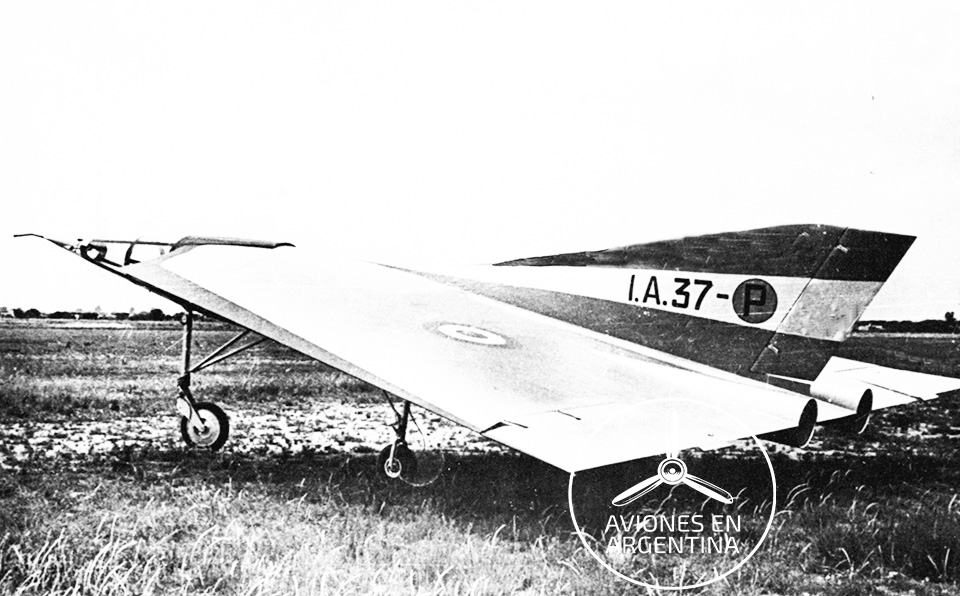
 avionesenargentina.com
avionesenargentina.com

Proyecto I.A. 37 Ala Delta , su primer vuelo
Proyecto I.A. 37 Ala Delta , su primer vuelo
 avionesenargentina.com
avionesenargentina.com
Last edited:
blockhaj
Swedish "want to be" aviation specialist
- Joined
- 9 February 2017
- Messages
- 406
- Reaction score
- 510
Sorry for necroing an old message, but i wonder what source the name E-1 comes from? E-1 kind of makes sense as it is the first Pulqui II to fly, but it is also the second prototype. Was the third prototype called E-2 etc? Which book is the "FMA Historical Book"?Today June 16, 2020 marks the 70th anniversary of the first flight of the prototype of the supersonic interceptor fighter I.Ae 33 Pulqui II E-1 The same was carried out on the Runway of the Military School of Parachuting, on June 16, 1950 at controls of Captain Edmundo Weiss The plane in question was equipped with a Rolls Royce "Nene" engine with a takeoff thrust of 2300 kg with a maximum speed of 1,040 K / Hs This same aircraft was presented on February 8, 1951 in the Aeropark before the then President General Juan Domingo Perón and the Prince Consort of the Netherlands being its pilot Kurt Tank Source FMA Historical Book
blockhaj
Swedish "want to be" aviation specialist
- Joined
- 9 February 2017
- Messages
- 406
- Reaction score
- 510
I started digging myself and found this: https://archive.org/stream/alan_147/SAFO 144_djvu.txt
If this text is correct then most books and sources about the Pulqui II are incorrect, with only 4 complete prototypes being made.
If this text is correct then most books and sources about the Pulqui II are incorrect, with only 4 complete prototypes being made.
- E-1- first prototype, armed with four 20 mm MG-151 cannons. First flight: June 16, 1950. Crashed: May 1951.
- E-2 - second prototype, initially unarmed and planned for static tests but was later modified to become flight worthy when the E-3 crashed in 1952. The modification was done in 1953 and included: first fitting of the planned armament of four 20 mm HS 804 cannons, one wing fence per wing, four trakes on the tail, air brakes, increased fuel capacity from 2,000 to 3,000 liters (as per E-3), strengthened landing gear (as per E-3), in-flight adjustable rudder (as per E-3). This modification is what i believe most people call "prototype 04" and the "prototype 02m" (modified), etc. Crashed 1956.
- E-3 - third prototype, unarmed. Modifications from E-1: increased fuel capacity (2,000 to 3,000 liters), strengthened landing gear, in-flight adjustable rudder. First flight: early 1952. Crashed october 1952.
- E-4 - fourth prototype, never completed with parts going into the E-5.
- E-5 - fifth prototype, completed in 1959 using parts from E-4 and E-6 as the final Pulqui II. It is called "Pulqui IIe" at times but was equal to the final E-2 but without armament. First flight: May 1960. Given to "Museo Nacional de Aeronáutica de Argentina" at the end of 1960.
- E-6 - sixth prototype, never completed with parts going into the E-5.
Here is a drawing of the Horten I.Ae.48 Mach-2.2 all-weather fighter with a pair of 11,000 lb-st (5000 kg-st) Rolls-Royce Avon turbojets mounted in nacelles on underwing pylons. The wingspan was about 30 ft (9 m) and maximum takeoff weight was 37,000 lb (16,800 kg). The crew reportedly sat in tandem, but the form of the drawings and wind-tunnel models that I have seen online makes the side-by-side arrangement shown seem more likely.
Attachments
Erdosain
ACCESS: Secret
- Joined
- 10 March 2020
- Messages
- 479
- Reaction score
- 1,976
This is a fan art, there was never a side-by-side two-seater IA-48. In the official drawings the IA-48 always had a tandem configuration. I saw the wind tunnel model and it is a tandem configuration, not side by side.Here is a drawing of the Horten I.Ae.48 Mach-2.2 all-weather fighter with a pair of 11,000 lb-st (5000 kg-st) Rolls-Royce Avon turbojets mounted in nacelles on underwing pylons. The wingspan was about 30 ft (9 m) and maximum takeoff weight was 37,000 lb (16,800 kg). The crew reportedly sat in tandem, but the form of the drawings and wind-tunnel models that I have seen online makes the side-by-side arrangement shown seem more likely.
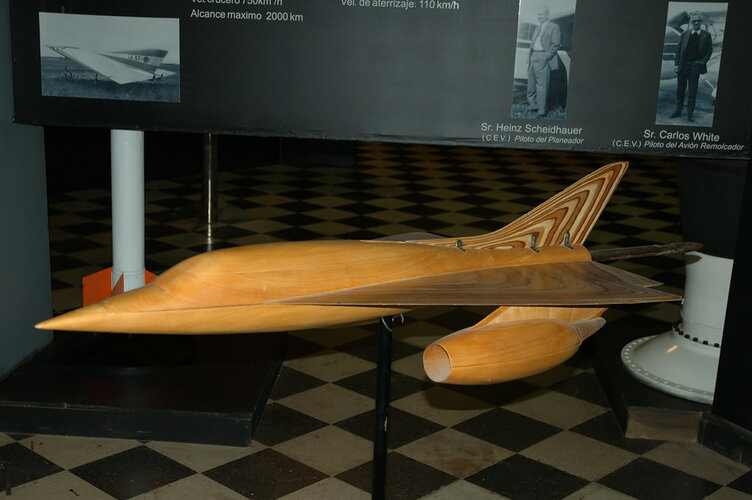
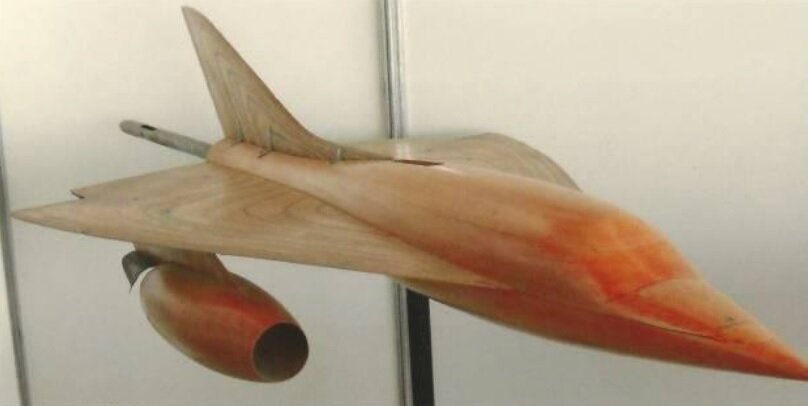
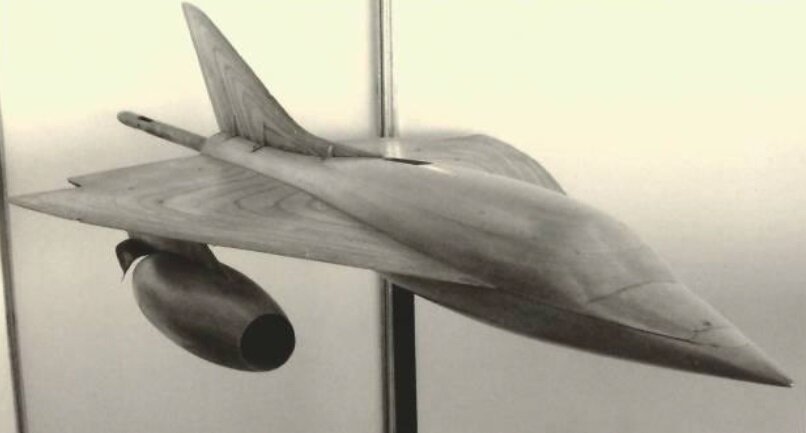
Last edited:
Similar threads
-
Argentine SAIA 90 fighter project
- Started by overscan (PaulMM)
- Replies: 24
-
-
-
AX-04: Last Torpedo Bomber development of the 20th Century?
- Started by Grey Havoc
- Replies: 14

